Table of contents
The red onion ( Allium cepa ) has red to dark purple onion skins. It has a mild spiciness and a slightly sweet aroma. Raw and organic, it is good for salads; cooked, it is suitable for soups and sauces.
Use in the kitchen
Red onions, like yellow and white, are kitchen or cooking onions. Their skin is much thinner than that of light varieties.
What do red onions taste like? The taste is very delicate and somewhat milder than that of white onions.
Can you eat red onions raw? Red onions are ideal for raw food cooking because they are mild and slightly sweet in taste. Raw red onions are particularly popular in salads, and when chopped they also add a touch of flavor to sauces or dips. Cut into rings, they make a good garnish, side dish or topping on bread.
Can you fry red onions? Red onions can also be used for cooking, e.g. in soups or dark sauces. When heated (boiling, stewing, frying, drying , etc.) the onions release sugar from their glycosidic compounds. They lose their spiciness and taste sweet. It is better not to fry shallots ( Allium ascalonicum ), which can easily be confused with red onions ( Allium cepa ) because of their red color. Cooked onions enhance almost any dish. They go well (depending on the color) in clear or thick soups, sauces, stews or casseroles. Red onions are also good with pasta , quiche or in parsnip and potato puree . They also taste good with sautéed or steamed vegetables, or you can stuff them with them.
When marinated in apple cider vinegar and herbs, the onions change color and flavor (pickles). Pickled small pearl onions, a variety without skin, are commercially available. Caramelized red onions are a popular chutney variant.
To reduce the slightly unpleasant smell of breath after eating raw onions, you can try the following: Chewing fresh green herbs such as mint, parsley or basil neutralizes the smell of onions with the chlorophyll they contain. You can also try lemon juice or water, apple cider vinegar (1 teaspoon in a glass of water) or green tea. A few cardamom seeds, chewed or brewed as a tea, can break down the sulfur compounds in a similar way to a fresh apple and thus reduce the smell.
Recipe for pickled red onions
Ingredients (for 4 people): 4 red onions, 200 ml vinegar (5%), 125 g sugar , 1/4 organic lemon , 100 ml water .
Preparation: Cut the lemon (with peel) and peeled onions into thin slices. Boil the water, vinegar and sugar for about 2 minutes and stir, then let the onions and lemon cook for about 1/2 minute. Fill the onions with the vinegar marinade into clean (boiled) preserving jars, allow to cool and store in a cool, dark place.
Vegan recipes with red onions can be found under the note: " Recipes that have the most of this ingredient ".
| Not only vegans or vegetarians should read this: Vegans often eat unhealthily. Avoidable nutritional mistakes . |
Purchasing - Storage
Red onions are available from supermarket chains such as Coop , Migros , Denner , Volg , Spar , Aldi , Lidl , Rewe , Edeka , Hofer , Billa . For special varieties, weekly markets, organic supermarkets ( Alnatura and Denn's Biomarkt ) or organic shops are suitable. Conventionally produced onions are mostly treated with fungicides to counteract the rapidly developing downy mildew ( Peronospora destructor ). We therefore recommend preferring organically produced onions (organic quality). Onions can be bought all year round as they can be stored for a long time.
Particularly well-known red onion varieties include Braunschweiger Dunkelblutrote, Di Genova, Karmen, etc. Their characteristics and sizes can vary considerably. The red onions sold in Europe often come from Italy.
The availability of red onions varies depending on the size of the store, catchment area, etc. Our recorded food prices for the DA-CH countries can be found above under the ingredient image - and by clicking on them you can see their development at different suppliers.
Found in the wild
There are apparently no direct wild ancestors of the Allium species. Related wild alliums are wild garlic ( Allium ursinum ), chives ( Allium schoenoprasum ), vegetable leek ( Allium oleraceum ), conspicuous or strange leek ( Allium paradoxum ) and others . 2
Storage tips
Fully ripe red onions with dry skin need a dry, cool environment protected from light. Freshly harvested red onions with green stems can be stored in the fridge for a few days. The best way to do this is to wrap them in damp kitchen paper. Cut onions quickly lose their aroma and spiciness, which is why they should be used up quickly. If you still have too much, a cheese cover or a sealable container that you can put in the fridge is ideal.
Ingredients - Nutritional value - Calories
Red onions (raw) contain an energy value of 40 kcal per 100 g. The calories come mainly from carbohydrates, proteins and fiber. Red onions are almost fat-free. 4
Onions do not contain starch, but fructans as a reserve substance. The human digestive system cannot break these down enzymatically and they are not absorbed in the small intestine. In the large intestine, the bacteria metabolize them and produce gas. 13
Except for vitamin B 12, raw red onions contain all vitamins in small amounts. 7.4 mg of vitamin C per 100 g doesn't sound like a lot, but it is more than cherries (7 mg) or peaches (6.6 mg). Kale has significantly more vitamin C at 119 mg/100g. 4
Red onions contain 0.12 mg of vitamin B 6 (pyridoxine) per 100g. Mangos and oats contain the same amount. Dried onions contain several times more, at 1.6 mg per 100g. 4
The folate (folic acid) content is not very high at 19 µg/100g, considering the daily requirement of 300 µg. Carrots and baby zucchini have the same values. Leeks contain more folic acid at 64 µg/100g. 4
The amount of the mineral potassium per 100 g of onions is 146 mg, and cucumbers have similar values. The calcium values of raw onions (23 mg/100g) are the same as those of cauliflower . The amount of the trace element manganese is 0.13 mg/100g, which is similar to that of figs and iceberg lettuce . 4
The trace element sulphur is a component of the essential oil, which is responsible for the typical smell. Onions also have a high content of quercetin, an effective flavonoid. 2 The cells of red onions (vacuoles) contain red pigments (anthocyanins, also flavonoids).
The complete ingredients of red onion, the coverage of the daily requirement and comparison values with other ingredients can be found in our nutrient tables. In the article Nutrients explained you will get a detailed insight into the topic.
Health effects
Are red onions healthy? Onions are rich in flavonoids, which improve blood circulation and prevent blood clots (anticoagulant effect) and arteriosclerosis. The essential oil and flavonoids are said to have antibiotic, bronchial, anti-asthmatic, cardio-vascular, diuretic and anti-cancer properties. Internally, onions, raw, boiled, fried or made into syrup, are effective against respiratory diseases. 5
A 2015 study examined the best-known health studies on onions and garlic and described the individual results. It comes to this conclusion regarding cancer prevention: Studies point to possible mechanisms of anti-cancer activity of various Allium plant extracts and preparations and underline the activities of sulfur-containing compounds. These compounds have effects at every stage of carcinogenesis and influence many physiological processes that modify the risk of cancer. 6
Sulfur compounds (sulfides) contained in onions inhibit the growth of negative bacteria in the stomach. Regular consumption of onions and garlic can reduce the risk of developing stomach cancer. 7
Why are red onions healthier? The anthocyanins contained in red onions are said to further enhance the effect of the anti-cancer flavonoid quercetin. 8
A study from Iran showed that regular consumption of red onions can lower cholesterol levels. The study examined women who were overweight or suffered from polycystic ovary syndrome (cysts on the ovaries). 9
Dangers - Intolerances - Side effects
Although most onions are poisonous or indigestible for humans, kitchen onions actually help to maintain our health. However, they can be poisonous for other mammals. Some allergy sufferers can develop contact eczema, in which - as with garlic - low-molecular sulphur compounds act as allergens. The onion contains other proteins that can trigger allergies: lipid transfer protein (All c 3), profilin (All c 4, cross-allergen with grass pollen), alliin lyase (cross-allergen with other types of allium). 10
Risk of confusion
It is possible to confuse them with flower bulbs that are not suitable for consumption, as these can also have reddish outer shells.
Folk medicine - natural healing
Onions are a versatile home remedy. Onion syrup helps with colds and can be taken several times a day, a spoonful at a time. To do this, mix chopped onions with honey and a little water and bring the whole thing to the boil over a low heat. The mixture is then left to stand for a few hours and the solids are filtered out. 11 The vapors from the onion are also used for inhalation when dealing with colds.
Onions are used externally for insect bites, wounds, boils and for the aftercare of bruises. Alliums also help against warts and corns. The pressed juice is also said to drive away (clothes) moths, insects and moles. 2 Onion juice mixed with a little yoghurt makes a face mask that is said to help against dark pigment spots and acne.
Fresh onions aid digestion, increase appetite, are diuretic and heal wounds. 11
Ecological footprint - animal welfare
When studying the ecological balance, no distinction is often made between the individual types of onion.
In 2019, the Institute for Energy and Environmental Research Heidelberg ( ifeu ) examined almost 200 foods in Germany for their environmental impact. The calculation of the ecological footprint is based on average values for agricultural production (including all upstream processes, such as fertilizer production), food processing, packaging (including disposal of the same) and distribution to the supermarket. Different cultivation methods (organic - conventional), domestic production vs. import by truck, ship or plane, etc. were also taken into account. For selected foods, the authors also point out the phosphate, water and land consumption. Onions (light and red varieties) perform excellently with 0.2 kg CO 2 eq/kg . 14
Another positive aspect for the environmental balance is the possibility of outdoor cultivation almost all year round in the DA-CH region if suitable varieties are chosen. 16 The amount of water required to produce 1 kg of onions is on average 272 litres. 15
Organic farmers struggle with pesticide-free onion cultivation, particularly with the high weed pressure. Downy mildew can also lead to significant crop failures. For this reason, organic onions are significantly more expensive than conventionally grown ones. 18 However, conventional onions often contain residues of plant protection products (pesticides, fungicides). 17 Ideally, therefore, you should buy organically produced onions.
Worldwide occurrence - cultivation
The onion is one of the oldest cultivated plants. It has been used as a medicinal plant, spice and vegetable for more than 5000 years. Since the wild ancestors are unknown, the geographical origin is also not clear. According to pharmacist M. Pahlow, summer onions come from western Asia and the Romans brought them to Central Europe. In the Balkan countries and the Orient, the onion is a more important vegetable plant than in western countries. The winter onion ( Allium fistulosum ) is said to come from southern Siberia. 11
According to FAOSTAT, 106.59 million tons of onions and shallots were produced worldwide in 2021. The main producing countries are India (26.64 million tons), the People's Republic of China (24.16 million tons) and Egypt (3.31 million tons). By comparison, Germany produced 738,540 tons in 2021, Austria 168,660 tons and Switzerland 49,000 tons. 1
Cultivation - Harvest
There are a wide variety of red onions. There are summer and winter onions. Summer onions are the actual kitchen onions, they are sown in spring and harvested between August and October. Winter onions are planted in August and harvested in June/July. They are a little milder 11 and juicier, but not as suitable for storage.
Onions need warm summer weather and plenty of light. A medium-heavy soil rich in humus and nutrients with good water retention is ideal. There are three ways to plant onions: direct sowing via seeds, onion sets or young plants. Direct sowing involves a long cultivation period and a lot of manual work, especially for weed control. Onion sets are probably the most suitable for the garden because they are easy to obtain and have a short cultivation period. 12
Onion sets grow from seeds that are sown very closely together; they are harvested when they are small, e.g. the size of a hazelnut. After harvesting, they must be stored in a warm place for 3-4 weeks (drying). Temperatures of 30 to 40 °C prevent bolting (flowering).
The onion sets are planted about 1-2 cm deep and at a row spacing of about 25 cm. They can be planted a little closer together in the row (about 15 cm). Plants that are planted too close together encourage fungal diseases such as downy mildew. In the garden, weeds can be removed by hand or with a finger hoe.
To ensure good storage, the stems of the plant and the skin should be somewhat dry. Never harvest when it is raining. If possible, the weather is still nice for a few days after harvesting, then you can simply lay the onions on the ground and leave them there for a few days. It is important that you keep turning the onions so that they can dry all over.
Further information
The red onion ( Allium cepa ) belongs to the genus Allium and to the Allium family (Allioideae). It used to be classified as a member of the lily family (Liliaceae). As a perennial or biennial plant, it does not flower until its second year. This is why cuttings that are exposed to low temperatures during drying often start to shoot. The flowers appear as spherical, white to lilac-colored umbels with 20 to over 100 individual flowers. The actual fruit, the onion, is the underground storage organ. It is formed from several interlocking, fleshy, thickened leaf bases of the leaves.
Tears - what can you do about it and how do they happen?
There are various ways to reduce the flow of tears when cutting onions. One is to use a moistened cutting board, as the water on the board reacts with the tear-inducing compound in the onions. Another method is to place the onions in the fridge. The cold slows down the processes that produce the unpleasant substance. A sharp knife also helps, as it destroys fewer onion cells (see explanation below). An open window or even a hairdryer also means that the tear-inducing compound only finds its way to your eyes to a small extent.
But why do tears flow when you cut onions? You will find out in the following sections: The destruction of the cell structure when cutting onions causes the components alliin, isoalliin and alliinase enclosed in the cells to come together. In an intact onion cell, they are housed separately in different structures.
Alliin and isoalliin are stable on their own and neither cause tears nor sting. But when they come into contact with alliinase, a chemical reaction takes place. This produces propanethial sulfoxide (the "lacrimation factor"). It is a volatile (quickly evaporating), gaseous compound that causes tears in our eyes. When this compound comes into contact with our eyes, the propanethial sulfoxide is converted into sulfuric acid, among other things, which irritates our eyes. The eyes protect themselves by producing tears. This concept (ie, the release of a defense substance when cells are destroyed) serves in nature as a defense against predators, but in our eyes it causes pressure on the tear gland. 3
Alternative names
Onions are also called zipolle, bolle, cooking onion, kitchen onion, garden onion, summer onion, house onion, yellow onion or common onion or onion leek. There are also many trivial names, some of which are only used regionally or are outdated.
The English name is red onion.
Other uses
The peels of red onions are also used for dyeing fabrics, yarns, felt, paper, wood and also eggs.

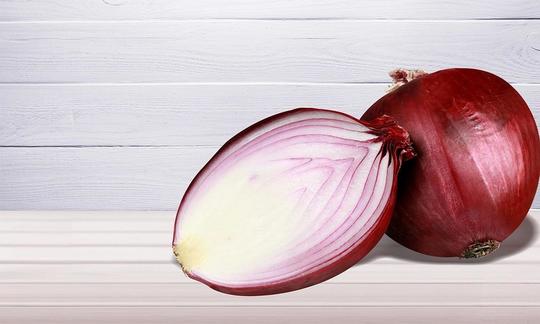

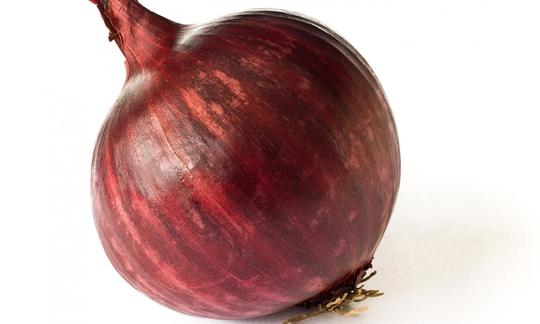

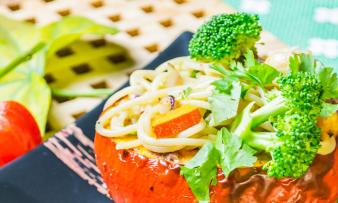
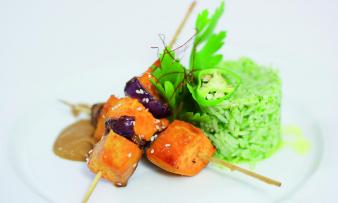
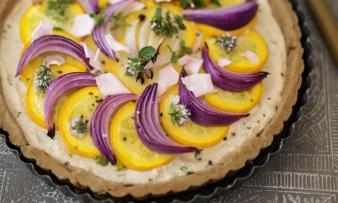





Comments